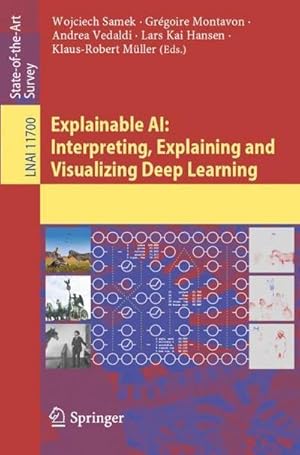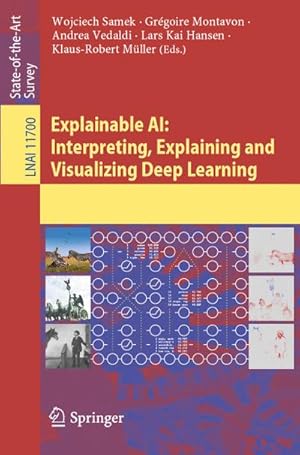Explainable Interpreting Explaining Visualizing (20 results)
Search filters
Product Type
- All Product Types
- Books (20)
- Magazines & Periodicals (No further results match this refinement)
- Comics (No further results match this refinement)
- Sheet Music (No further results match this refinement)
- Art, Prints & Posters (No further results match this refinement)
- Photographs (No further results match this refinement)
- Maps (No further results match this refinement)
- Manuscripts & Paper Collectibles (No further results match this refinement)
Condition Learn more
- New (16)
- As New, Fine or Near Fine (2)
- Very Good or Good (2)
- Fair or Poor (No further results match this refinement)
- As Described (No further results match this refinement)
Binding
- All Bindings
- Hardcover (No further results match this refinement)
- Softcover (20)
Collectible Attributes
- First Edition (No further results match this refinement)
- Signed (No further results match this refinement)
- Dust Jacket (No further results match this refinement)
- Seller-Supplied Images (10)
- Not Print on Demand (17)
Language (1)
Price
- Any Price
- Under US$ 25 (No further results match this refinement)
- US$ 25 to US$ 50 (No further results match this refinement)
- Over US$ 50
Free Shipping
Seller Location
Seller Rating
-
Explainable AI: Interpreting, Explaining and Visualizing Deep Learning (Lecture Notes in Computer Science)
Seller: Books From California, Simi Valley, CA, U.S.A.
Paperback. Condition: Good. Minor shelf wear/ creasing on cover.
-
paperback. Condition: Good. Connecting readers with great books since 1972! Used textbooks may not include companion materials such as access codes, etc. May have some wear or writing/highlighting. We ship orders daily and Customer Service is our top priority!
-
Explainable Ai : Interpreting, Explaining and Visualizing Deep Learning
Seller: GreatBookPrices, Columbia, MD, U.S.A.
Condition: As New. Unread book in perfect condition.
-
Explainable Ai : Interpreting, Explaining and Visualizing Deep Learning
Seller: GreatBookPrices, Columbia, MD, U.S.A.
Condition: New.
-
Explainable AI: Interpreting, Explaining and Visualizing Deep Learning
Language: English
Published by Springer Nature Switzerland AG, CH, 2019
ISBN 10: 3030289532 ISBN 13: 9783030289539
Seller: Rarewaves.com USA, London, LONDO, United Kingdom
US$ 76.34
Free Shipping
Ships from United Kingdom to U.S.A.Quantity: Over 20 available
Add to basketPaperback. Condition: New. 2019 ed. The development of "intelligent" systems that can take decisions and perform autonomously might lead to faster and more consistent decisions. A limiting factor for a broader adoption of AI technology is the inherent risks that come with giving up human control and oversight to "intelligent" machines. For sensitive tasks involving critical infrastructures and affecting human well-being or health, it is crucial to limit the possibility of improper, non-robust and unsafe decisions and actions. Before deploying an AI system, we see a strong need to validate its behavior, and thus establish guarantees that it will continue to perform as expected when deployed in a real-world environment. In pursuit of that objective, ways for humans to verify the agreement between the AI decision structure and their own ground-truth knowledge have been explored. Explainable AI (XAI) has developed as a subfield of AI, focused on exposing complex AI models to humans in a systematic and interpretable manner.The 22 chapters included in this book provide a timely snapshot of algorithms, theory, and applications of interpretable and explainable AI and AI techniques that have been proposed recently reflecting the current discourse in this field and providing directions of future development. The book is organized in six parts: towards AI transparency; methods for interpreting AI systems; explaining the decisions of AI systems; evaluating interpretability and explanations; applications of explainable AI; and software for explainable AI.
-
Explainable AI: Interpreting, Explaining and Visualizing Deep Learning
Seller: Chiron Media, Wallingford, United Kingdom
US$ 59.29
US$ 20.86 shipping
Ships from United Kingdom to U.S.A.Quantity: 10 available
Add to basketPF. Condition: New.
-
Explainable Ai : Interpreting, Explaining and Visualizing Deep Learning
Seller: GreatBookPricesUK, Woodford Green, United Kingdom
US$ 62.74
US$ 20.20 shipping
Ships from United Kingdom to U.S.A.Quantity: Over 20 available
Add to basketCondition: New.
-
Explainable Ai : Interpreting, Explaining and Visualizing Deep Learning
Seller: GreatBookPricesUK, Woodford Green, United Kingdom
US$ 68.89
US$ 20.20 shipping
Ships from United Kingdom to U.S.A.Quantity: Over 20 available
Add to basketCondition: As New. Unread book in perfect condition.
-
Condition: New.
-
Condition: New.
-
Explainable AI: Interpreting, Explaining and Visualizing Deep Learning
Language: English
Published by Springer Nature Switzerland AG, CH, 2019
ISBN 10: 3030289532 ISBN 13: 9783030289539
Seller: Rarewaves.com UK, London, United Kingdom
US$ 74.15
US$ 87.55 shipping
Ships from United Kingdom to U.S.A.Quantity: Over 20 available
Add to basketPaperback. Condition: New. 2019 ed. The development of "intelligent" systems that can take decisions and perform autonomously might lead to faster and more consistent decisions. A limiting factor for a broader adoption of AI technology is the inherent risks that come with giving up human control and oversight to "intelligent" machines. For sensitive tasks involving critical infrastructures and affecting human well-being or health, it is crucial to limit the possibility of improper, non-robust and unsafe decisions and actions. Before deploying an AI system, we see a strong need to validate its behavior, and thus establish guarantees that it will continue to perform as expected when deployed in a real-world environment. In pursuit of that objective, ways for humans to verify the agreement between the AI decision structure and their own ground-truth knowledge have been explored. Explainable AI (XAI) has developed as a subfield of AI, focused on exposing complex AI models to humans in a systematic and interpretable manner.The 22 chapters included in this book provide a timely snapshot of algorithms, theory, and applications of interpretable and explainable AI and AI techniques that have been proposed recently reflecting the current discourse in this field and providing directions of future development. The book is organized in six parts: towards AI transparency; methods for interpreting AI systems; explaining the decisions of AI systems; evaluating interpretability and explanations; applications of explainable AI; and software for explainable AI.
-
Explainable AI: Interpreting, Explaining and Visualizing Deep Learning
Seller: Books Puddle, New York, NY, U.S.A.
Condition: New.
-
Explainable AI: Interpreting, Explaining and Visualizing Deep Learning (Lecture Notes in Computer Science (11700))
Seller: Mispah books, Redhill, SURRE, United Kingdom
US$ 145.67
US$ 33.67 shipping
Ships from United Kingdom to U.S.A.Quantity: 1 available
Add to basketPaperback. Condition: New. NEW. SHIPS FROM MULTIPLE LOCATIONS. book.
-
Explainable Ai: Interpreting, Explaining and Visualizing Deep Learning
Language: English
Published by Springer-Verlag New York Inc, 2019
ISBN 10: 3030289532 ISBN 13: 9783030289539
Seller: Revaluation Books, Exeter, United Kingdom
US$ 179.93
US$ 16.84 shipping
Ships from United Kingdom to U.S.A.Quantity: 2 available
Add to basketPaperback. Condition: Brand New. 438 pages. 9.50x6.25x0.75 inches. In Stock.
-
Explainable AI: Interpreting, Explaining and Visualizing Deep Learning
Seller: preigu, Osnabrück, Germany
Taschenbuch. Condition: Neu. Explainable AI: Interpreting, Explaining and Visualizing Deep Learning | Wojciech Samek (u. a.) | Taschenbuch | xi | Englisch | 2019 | Springer | EAN 9783030289539 | Verantwortliche Person für die EU: Springer Verlag GmbH, Tiergartenstr. 17, 69121 Heidelberg, juergen[dot]hartmann[at]springer[dot]com | Anbieter: preigu.
-
Explainable AI: Interpreting, Explaining and Visualizing Deep Learning
Language: English
Published by Springer International Publishing, Springer Nature Switzerland Aug 2019, 2019
ISBN 10: 3030289532 ISBN 13: 9783030289539
Seller: buchversandmimpf2000, Emtmannsberg, BAYE, Germany
Taschenbuch. Condition: Neu. Neuware -The development of ¿intelligent¿ systems that can take decisions and perform autonomously might lead to faster and more consistent decisions. A limiting factor for a broader adoption of AI technology is the inherent risks that come with giving up human control and oversight to ¿intelligent¿ machines. For sensitive tasks involving critical infrastructures and affecting human well-being or health, it is crucial to limit the possibility of improper, non-robust and unsafe decisions and actions. Before deploying an AI system, we see a strong need to validate its behavior, and thus establish guarantees that it will continue to perform as expected when deployed in a real-world environment. In pursuit of that objective, ways for humans to verify the agreement between the AI decision structure and their own ground-truth knowledge have been explored. Explainable AI (XAI) has developed as a subfield of AI, focused on exposing complex AI models to humans in a systematic and interpretable manner.The 22 chapters included in this book provide a timely snapshot of algorithms, theory, and applications of interpretable and explainable AI and AI techniques that have been proposed recently reflecting the current discourse in this field and providing directions of future development. The book is organized in six parts: towards AI transparency; methods for interpreting AI systems; explaining the decisions of AI systems; evaluating interpretability and explanations; applications of explainable AI; and software for explainable AI.Springer Verlag GmbH, Tiergartenstr. 17, 69121 Heidelberg 452 pp. Englisch.
-
Explainable AI: Interpreting, Explaining and Visualizing Deep Learning
Language: English
Published by Springer International Publishing, Springer Nature Switzerland, 2019
ISBN 10: 3030289532 ISBN 13: 9783030289539
Seller: AHA-BUCH GmbH, Einbeck, Germany
Taschenbuch. Condition: Neu. Druck auf Anfrage Neuware - Printed after ordering - The development of 'intelligent' systems that can take decisions and perform autonomously might lead to faster and more consistent decisions. A limiting factor for a broader adoption of AI technology is the inherent risks that come with giving up human control and oversight to 'intelligent' machines. Forsensitive tasks involving critical infrastructures and affecting human well-being or health, it is crucial to limit the possibility of improper, non-robust and unsafe decisions and actions. Before deploying an AI system, we see a strong need to validate its behavior, and thus establish guarantees that it will continue toperform as expected when deployed in a real-world environment. In pursuit of that objective, ways for humans to verify the agreement between the AI decision structure and their own ground-truth knowledge have been explored. Explainable AI (XAI) has developed as a subfield of AI, focused on exposing complex AI models to humans in a systematic and interpretable manner.The 22 chapters included in this book provide a timely snapshot of algorithms, theory, and applications ofinterpretable and explainable AI and AI techniques that have been proposed recently reflecting the current discourse in this field and providing directions of future development. The book is organized in six parts: towards AI transparency; methods for interpreting AI systems; explaining the decisions of AI systems;evaluating interpretability and explanations; applications of explainable AI; and software for explainable AI.
-
Explainable AI: Interpreting, Explaining and Visualizing Deep Learning
Language: English
Published by Springer International Publishing, Springer Nature Switzerland Aug 2019, 2019
ISBN 10: 3030289532 ISBN 13: 9783030289539
Seller: BuchWeltWeit Ludwig Meier e.K., Bergisch Gladbach, Germany
Taschenbuch. Condition: Neu. This item is printed on demand - it takes 3-4 days longer - Neuware -The development of 'intelligent' systems that can take decisions and perform autonomously might lead to faster and more consistent decisions. A limiting factor for a broader adoption of AI technology is the inherent risks that come with giving up human control and oversight to 'intelligent' machines. Forsensitive tasks involving critical infrastructures and affecting human well-being or health, it is crucial to limit the possibility of improper, non-robust and unsafe decisions and actions. Before deploying an AI system, we see a strong need to validate its behavior, and thus establish guarantees that it will continue toperform as expected when deployed in a real-world environment. In pursuit of that objective, ways for humans to verify the agreement between the AI decision structure and their own ground-truth knowledge have been explored. Explainable AI (XAI) has developed as a subfield of AI, focused on exposing complex AI models to humans in a systematic and interpretable manner.The 22 chapters included in this book provide a timely snapshot of algorithms, theory, and applications ofinterpretable and explainable AI and AI techniques that have been proposed recently reflecting the current discourse in this field and providing directions of future development. The book is organized in six parts: towards AI transparency; methods for interpreting AI systems; explaining the decisions of AI systems;evaluating interpretability and explanations; applications of explainable AI; and software for explainable AI. 452 pp. Englisch.
-
Explainable AI: Interpreting, Explaining and Visualizing Deep Learning
Seller: Majestic Books, Hounslow, United Kingdom
US$ 164.61
US$ 8.75 shipping
Ships from United Kingdom to U.S.A.Quantity: 4 available
Add to basketCondition: New. Print on Demand This item is printed on demand.
-
Explainable AI: Interpreting, Explaining and Visualizing Deep Learning
Seller: Biblios, Frankfurt am main, HESSE, Germany
Condition: New. PRINT ON DEMAND.












